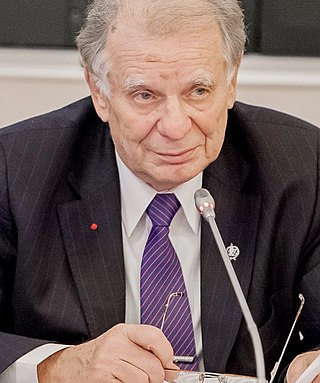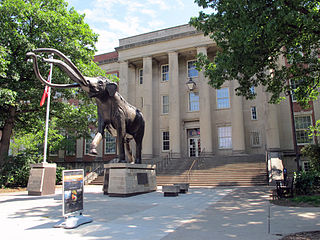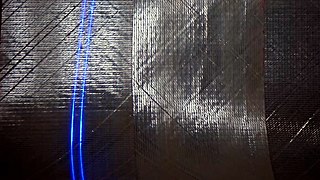Related Research Articles

A laser is a device that emits light through a process of optical amplification based on the stimulated emission of electromagnetic radiation. The word laser is an anacronym that originated as an acronym for light amplification by stimulated emission of radiation. The first laser was built in 1960 by Theodore Maiman at Hughes Research Laboratories, based on theoretical work by Charles H. Townes and Arthur Leonard Schawlow.

Zhores Ivanovich Alferov was a Soviet and Russian physicist and academic who contributed significantly to the creation of modern heterostructure physics and electronics. He shared the 2000 Nobel Prize in Physics for the development of the semiconductor heterojunction for optoelectronics. He also became a politician in his later life, serving in the lower house of the Russian parliament, the State Duma, as a member of the Communist Party from 1995.

Photonics is a branch of optics that involves the application of generation, detection, and manipulation of light in form of photons through emission, transmission, modulation, signal processing, switching, amplification, and sensing. Photonics is closely related to quantum electronics, where quantum electronics deals with the theoretical part of it while photonics deal with its engineering applications. Though covering all light's technical applications over the whole spectrum, most photonic applications are in the range of visible and near-infrared light. The term photonics developed as an outgrowth of the first practical semiconductor light emitters invented in the early 1960s and optical fibers developed in the 1970s.

Stereoscopy is a technique for creating or enhancing the illusion of depth in an image by means of stereopsis for binocular vision. The word stereoscopy derives from Greek στερεός (stereos) 'firm, solid', and σκοπέω (skopeō) 'to look, to see'. Any stereoscopic image is called a stereogram. Originally, stereogram referred to a pair of stereo images which could be viewed using a stereoscope.

Theodore Harold Maiman was an American engineer and physicist who is widely credited with the invention of the laser. Maiman's laser led to the subsequent development of many other types of lasers. The laser was successfully fired on May 16, 1960. In a July 7, 1960, press conference in Manhattan, Maiman and his employer, Hughes Aircraft Company, announced the laser to the world. Maiman was granted a patent for his invention, and he received many awards and honors for his work. His experiences in developing the first laser and subsequent related events are recounted in his book, The Laser Odyssey, later being republished in 2018 under a new title, The Laser Inventor: Memoirs of Theodore H. Maiman.

A laser lighting display or laser light show involves the use of laser light to entertain an audience. A laser light show may consist only of projected laser beams set to music, or may accompany another form of entertainment, typically musical performances.

The University of Nebraska State Museum, also known as Morrill Hall, founded in 1871, is a natural history museum featuring Nebraska biodiversity, paleontology, and cultural diversity, located on the University of Nebraska–Lincoln City Campus near the corner of 14th and Vine Streets in Lincoln, Nebraska, United States. The museum houses Mueller Planetarium, a hands-on science discovery center, and the Elephant Hall, where visitors can see the world's largest articulated fossil mammoth among the collection of fossil elephants. Also featured are interactive paleontology exhibits, a dinosaur gallery, ancient life and evolution exhibits, wildlife dioramas, gems and minerals, American Indian and African exhibits, and a temporary exhibit gallery featuring rotating displays on diverse topics including photography, quilts and fine arts.
Manick Sorcar is an Indian American artist, animator, engineer, and laserist. Sorcar is an artist in various media, including fine arts, cartoons, animations, laser arts, and world-touring stage shows with live action mixed with laser animation. His animated films, all based on children's stories from India, have won prestigious awards at international film festivals and been broadcast on the Public Broadcasting Service for 25 consecutive years. His laser arts and animation in various forms have won global awards from the International Laser Display Association.
SPIE is an international not-for-profit professional society for optics and photonics technology, founded in 1955. It organizes technical conferences, trade exhibitions, and continuing education programs for researchers and developers in the light-based fields of physics, including: optics, photonics, and imaging engineering. The society publishes peer-reviewed scientific journals, conference proceedings, monographs, tutorial texts, field guides, and reference volumes in print and online. SPIE is especially well-known for Photonics West, one of the laser and photonics industry's largest combined conferences and tradeshows which is held annually in San Francisco. SPIE also participates as partners in leading educational initiatives, and in 2020, for example, provided more than $5.8 million in support of optics education and outreach programs around the world.
The Technology and Engineering Emmy Awards, or Technology and Engineering Emmys, are one of two sets of Emmy Awards that are presented for outstanding achievement in engineering development in the television industry. The Technology and Engineering Emmy Awards are presented by the National Academy of Television Arts and Sciences (NATAS), while the separate Primetime Engineering Emmy Awards are given by its sister organization the Academy of Television Arts & Sciences (ATAS).

Audience scanning is when a laser lighting display is directed towards its audience. Although this is preferred for many laser effects such as tunnels, it is potentially dangerous due to the high levels of laser radiation exposed to the eyes of audience members.

The Themed Entertainment Association (TEA) is an international non-profit association that represents creators, developers, designers and producers of themed entertainment. It is also noted for its THEA Awards, which were founded in 1995 and are distributed annually in a range of themed entertainment categories.
Ivan Dryer is generally considered to be the father of the commercial laser light show industry. He is the founder of the world's first continuously running laser entertainment, known as Laserium.
Laser color television, or laser color video display, is a type of television that utilizes two or more individually modulated optical (laser) rays of different colors to produce a combined spot that is scanned and projected across the image plane by a polygon-mirror system or less effectively by optoelectronic means to produce a color-television display. The systems work either by scanning the entire picture a dot at a time and modulating the laser directly at high frequency, much like the electron beams in a cathode ray tube, or by optically spreading and then modulating the laser and scanning a line at a time, the line itself being modulated in much the same way as with digital light processing (DLP).
The Electrochemical Society is a learned society based in the United States that supports scientific inquiry in the field of electrochemistry solid-state science and related technology. The Society membership comprises more than 8,000 scientists and engineers in over 85 countries at all degree levels and in all fields of electrochemistry, solid-state science and related technologies. Additional support is provided by institutional members including corporations and laboratories.

A laser projector is a device that projects changing laser beams on a screen to create a moving image for entertainment or professional use. It consists of a housing that contains lasers, mirrors, galvanometer scanners, and other optical components. A laser projector may contain one laser light source for single-color projection or three sources for RGB full color projection.
A solar-pumped laser is a laser that shares the same optical properties as conventional lasers such as emitting a beam consisting of coherent electromagnetic radiation which can reach high power, but which uses solar radiation for pumping the lasing medium. This type of laser is unique from other types in that it does not require any artificial energy source. There is even a hypothetical megastructure called a stellaser which uses a star as both the power source and the lasing medium.

LIA - The Laser Institute is an international professional society with a focus on laser applications and laser safety. LIA was founded on February 7, 1968, as the Laser Industry Association, and acts as secretariat to the Accredited Standards Committee (ASC) Z136, which develops and maintains the Z136 series of laser safety standards. LIA is publisher of these American National Standards Institute (ANSI) Z136 laser safety standards, which provide the foundation of laser safety programs nationally.
Yves Pépin is a creator of multimedia shows and large-scale events including the multi-awarded Eiffel Tower Millennium Show. In the course of his career, Pépin's projects have been honored with many awards; an outstanding personal honor was received in 2006, when his peers in the Themed Entertainment Association, the international association for creators of compelling places and experiences, presented him with the prestigious TEA Thea Award for a Lifetime of Distinguished Achievements.

Hui Cao (曹蕙) is a Chinese American physicist who is the professor of applied physics, a professor of physics and a professor of electrical engineering at Yale University. Her research interests are mesoscopic physics, complex photonic materials and devices, with a focus on non-conventional lasers and their unique applications. She is an elected member of the US National Academy of Sciences and of the American Academy of Arts and Sciences.
References
- 1 2 3 "Our Mission". Archived from the original on 2008-04-27. Retrieved 2024-05-06.
- 1 2 3 4 5 Walsh, Tim. "ILDA Founding Meeting (1986)". Archived from the original on 2008-04-27. Retrieved 2024-05-06.
- 1 2 3 "ILDA Conference Overview". Archived from the original on 2008-04-27. Retrieved 2024-05-06.
- ↑ Lytle, David; Kincade, Kathy (February 2004). "ILDA Meeting Honors Creativity". Laser Focus World. 40 (2): 19–24.